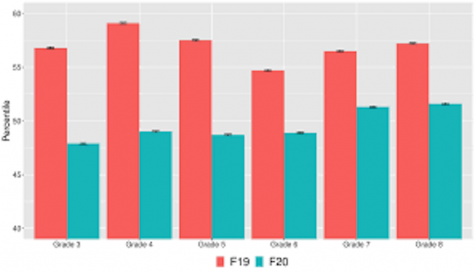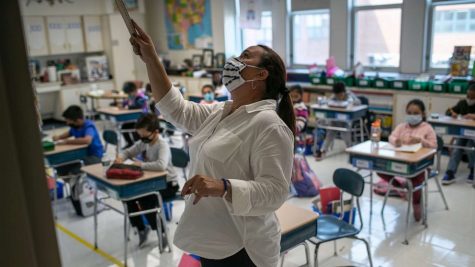A year of challenges leads to long-term struggles for the young
Children have been deeply affected as a result of COVID-19 restrictions.
Worldwide, the coronavirus pandemic has impacted different age groups in a variety of ways. The consequences for children provide unique challenges. Since March 2020, many young students have been unable to attend in-person school, resulting in educational setbacks as well as feelings of isolation. In addition to public health concerns, COVID-19 has created long-lasting medical, academic, social, and psychological obstacles for younger generations.
Although the symptoms of the virus affect children less intensely than adults, they are still at risk. Children who have asthma, diabetes, and immune system disorders are more likely to have an adverse reaction to COVID-19, according to mcleodhealth.org. Multi-System Inflammatory Syndrome in Children (MISC), a side effect of coronavirus that is only found in children, emerged soon after the initial viral outbreak. This response to COVID-19 leaves children severely ill with fevers, swollen hands and feet, and infected red eyes. Although most children will not experience severe symptoms if they contract COVID-19, MISC is a serious condition that can affect important organs such as the heart, lungs, kidneys, brain, and skin, according to intermountainhealthcare.org. MISC concerns doctors as it may leave healthy children with lasting health difficulties.
Following the transition to online learning, students are falling behind academically compared to the performance of children in previous years. Research on student achievement during COVID-19 shows mathematics scores dropping five to ten points lower compared to the fall of 2019, with statistical trends also showing lower test grades overall, according to nwea.org. Absences have increased due to quarantine regulations, illness, and technological issues. The shift to online schooling is difficult for children because the virtual format differs from a normal, collaborative learning environment and requires children to be consistently attentive and have an emotional balance, according to harvard.edu.

When schools closed worldwide, 463 million underprivileged children around the world did not have internet access. Virtual learning also created an obstacle for schools in developing countries as they are unable to afford the technological materials needed for remote schooling. Children in poverty face additional disadvantages as a result of the coronavirus pandemic as they have limited access to education, health care, adequate housing, nutrition, sanitation, or water, according to data.unicef.org. About 150 million children live in multidimensional poverty without these basic needs.
Although COVID-19 rarely infects children under the age of 10, daycare facilities still constitute a threat of infection to the families of children, according to The New York Times. Daycare programs provide an essential service for front-line workers with children, but they also increase the risk of spreading COVID-19. Research shows that childcare programs put children, adults with whom they come into contact, and anyone else they encounter at risk as they cannot maintain social distancing, according to The Washington Post. However, daycares can reduce this risk by following safety measures such as wearing masks and detecting symptoms of COVID-19 before any possible further infection.
The coronavirus pandemic has also created stress on adults through the loss of jobs or economic issues. Families confined to their homes due to quarantine restrictions increases the danger of domestic abuse, but because of public health regulations, certain child protective services are not currently available. Heightened tension in households due to COVID-19-induced stress contributes to violence. Sixty-six percent of countries reported that the coronavirus pandemic disrupted response services against domestic violence, according to data.unicef.org.
Isolation under quarantine restrictions is influencing children’s social development, according to ncbi.gov. Loneliness will impact the future mental health of children, whether it is coping with a loss of a loved one or separation from family members. Socializing is also important for child development. Understanding and communicating with those around them in a classroom expand necessary social skills at a young age. These interactions help children to comprehend their emotions and those of others, which is useful for their behavior as adults. Isolation also increases the possibility of depression and anxiety in children, even after quarantine ends.

The psychological issues that the coronavirus pandemic introduced could lead to a rise in the likelihood of mental illnesses throughout adulthood. Higher numbers of young children are experiencing depression, anxiety, and trauma, according to nbcnews.com. During the COVID-19 lockdown of March 2020, emergency departments detected an increase in mental health-related visits from children. Visits pertaining to the mental health of children aged 5 to 11 increased 24 percent and visits from teenagers aged 12 to 17 increased 31 percent, according to cdc.gov.
Dr. Melissa Otero, School Psychologist and Lead Wellness Strand of the Department of Student Support Services, acknowledges the barriers children face due to coronavirus pandemic and their effect on childhood development.
“Research is showing an increase in pandemic-related depression and anxiety in children and teenagers due to social isolation, anxiety around getting sick, and disruptions to daily life and schooling. Students who have not been able to attend school in-person have been hit particularly hard, as the school day provides so many opportunities for connection that are difficult to replicate on zoom,” Dr. Otero said. “Additionally, there is a very real fatigue factor when it comes to zoom. In face-to-face conversation, there are natural pauses and breaks in conversation, but on zoom, we are getting near-constant eye contact, which adds to the intensity. We are also forced to stare at ourselves, which does not happen in face-to-face interactions, and this can lead to more frequent self-evaluation and self-criticism.”
Featured Image by Kelly Haggerty ’23

Kelly is ecstatic for her third and final year on the paper, returning as a Content Editor. In her fourth year at Sacred Heart she is looking forward to...



Mary Jane Haggerty • Apr 13, 2021 at 12:11 pm
Excellent information on how all ages of students suffer from the COVID year. Hopefully it will be better. Thanks for all the information
Catherine Butler • Apr 9, 2021 at 9:31 pm
Kelly, you have done an excellent job in describing the negative impact of the CoVid pandemic on teens and children. A very comprehensive and well-written piece of journalism. Congratulations!